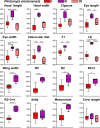Hidden diversity in anthropophilic sand flies of the Monticola Series (Diptera, Psychodidae)
- PMID: 39516507
- PMCID: PMC11549381
- DOI: 10.1038/s41598-024-77249-1
Hidden diversity in anthropophilic sand flies of the Monticola Series (Diptera, Psychodidae)
Erratum in
-
Author Correction: Hidden diversity in anthropophilic sand flies of the Monticola Series (Diptera, Psychodidae).Sci Rep. 2024 Dec 9;14(1):30426. doi: 10.1038/s41598-024-81429-4. Sci Rep. 2024. PMID: 39653693 Free PMC article. No abstract available.
Abstract
The Monticola series comprises two anthropophilic and widely distributed species in Brazil: Pintomyia (Pifanomyia) monticola (Costa Lima, 1932) and Pintomyia (Pifanomyia) misionensis (Castro, 1959). They mainly occur in the Atlantic Rainforest, and it is known that Pi. monticola comprises at least two well-structured genetic lineages regarding a fragment of the cytochrome c oxidase subunit I (COI) gene. Here, we aim to elucidate the taxonomic status of this group using integrative taxonomy tools. Collections were performed in nine localities of four Brazilian states, and COI fragments were sequenced and merged with publicly available data. Several single-locus species delimitation algorithms, genetic distance metrics, phylogenetic trees, and haplotype networks were used to uncover cryptic diversity and population structure within Pi. monticola and Pi. misionensis. The resulting genetic clusters were then tested for morphological differences through linear and geometric morphometry of several characters. We analyzed 152 COI sequences, comprising 48 haplotypes. The maximum intraspecific p distances were 8.21% (mean 4.17%) and 9.12% (mean 4.4%) for Pi. monticola and Pi. misionensis, respectively, while interspecific ones ranged from 10.94 to 14.09% (mean 12.33%). Phylogenetic gene trees showed well-supported clades for both species, with clear structuring patterns within them. Species-delimitation algorithms split our dataset into at least three putative species for each taxon. Moreover, population structure analysis showed a strong correlation between Atlantic Forest areas of endemism as sources of molecular variation in Pi. monticola. Morphometric analyses were significant for wing shape variation and some linear measurements (mainly of the head) when comparing specimens of different genetic clusters for both taxa. These results indicate strong genetic structuring of Monticola series species, confirmed by morphometry, indicating two possible cryptic species complexes.
Keywords: DNA barcoding; Geometric morphometry; Integrative taxonomy; Population genetics; Sand fly.
© 2024. The Author(s).
Conflict of interest statement
The authors declare no competing interests.
Figures






Similar articles
-
An integrative taxonomic approach reveals two putatively novel species of phlebotomine sand fly (Diptera: Psychodidae) in Thailand.Parasit Vectors. 2025 Jan 6;18(1):1. doi: 10.1186/s13071-024-06640-8. Parasit Vectors. 2025. PMID: 39762896 Free PMC article.
-
Molecular and morphometric study of Brazilian populations of Psychodopygus davisi.Med Vet Entomol. 2024 Mar;38(1):83-98. doi: 10.1111/mve.12701. Epub 2023 Oct 22. Med Vet Entomol. 2024. PMID: 37867259
-
New sand fly (Diptera, Psychodidae) records and COI DNA barcodes in the state of Maranhão, Eastern Amazon, Brazil.Acta Trop. 2024 Feb;250:107095. doi: 10.1016/j.actatropica.2023.107095. Epub 2023 Dec 12. Acta Trop. 2024. PMID: 38097151
-
Molecular taxonomy of phlebotomine sand flies (Diptera, Psychodidae) with emphasis on DNA barcoding: A review.Acta Trop. 2023 Feb;238:106778. doi: 10.1016/j.actatropica.2022.106778. Epub 2022 Nov 24. Acta Trop. 2023. PMID: 36435214 Review.
-
Hybridization in Phlebotominae (Diptera: Psychodidae): A mini-review.Infect Genet Evol. 2020 Dec;86:104593. doi: 10.1016/j.meegid.2020.104593. Epub 2020 Oct 11. Infect Genet Evol. 2020. PMID: 33053414 Review.
Cited by
-
Appearance may be deceiving: Mexican sand flies (Diptera: Psychodidae: Phlebotominae) embrace a high diversity of cryptic species.J Insect Sci. 2025 Jul 15;25(4):4. doi: 10.1093/jisesa/ieaf070. J Insect Sci. 2025. PMID: 40708374 Free PMC article.
References
-
- Galati, E. A. B. & Rodrigues, B. L. A review of historical Phlebotominae taxonomy (Diptera: Psychodidae). Neotrop. Entomol. 52, 539–559 (2023). - PubMed
-
- Galati, E. A. B. phylogenetic systematics of the Phlebotominae (Diptera, Psychodidae) with emphasis on American groups. Boletín De Malariología Y Salud Ambiental. 35, 133–142 (1995).
-
- Galati, E. A. B. & Phlebotominae (Diptera, Psychodidae): classification, morphology and terminology of adults and identification of American Taxa. In: (eds Rangel, E. & Shaw, J.) Brazilian Sand Flies. Springer, Cham (2018).
-
- Ibáñez-Bernal, S., Kraemer, M. S., Stebner, F. & Wagner, R. A new fossil species of Phlebotominae sand fly from Miocene amber of Chiapas, Mexico (Diptera: Psychodidae). PalZ. 88, 227–233 (2014).
MeSH terms
Substances
Grants and funding
LinkOut - more resources
Full Text Sources
Research Materials
Miscellaneous

